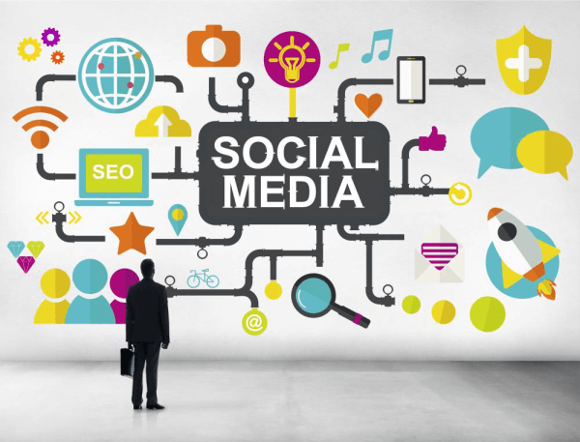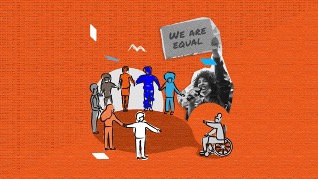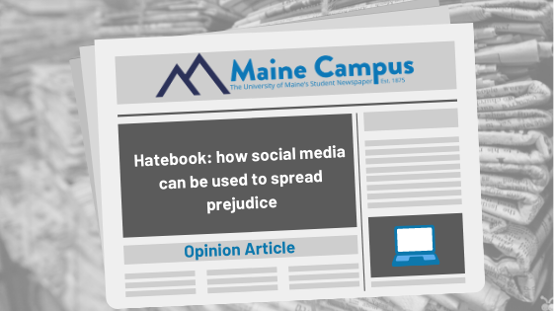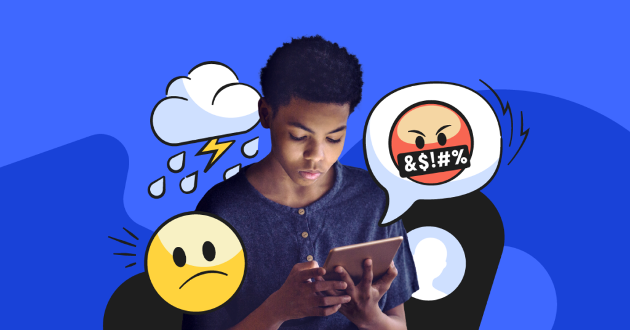The onset of social media is proving to be a revolutionary force in the increasingly changing interconnected world. It has changed how individuals communicate, exchange information, and relate or contact others from different cultures. However, social media has raised the issue of prejudice-the highly complex issue that exists at the bottom of many societies’ lives. Since the virtual world has become vital in people’s everyday lives, understanding how social media interacts with prejudice is essential. The role of social media in promoting or preventing prejudice is highly paradoxical, as it acts as a catalyst while serving as a platform that allows for such manifestations in society, on the other hand.

Social media and Overcoming Barriers
One key strength of social media is that it enables marginalized groups to speak out. Mainstream media has historically failed to represent or reflect the story of marginalized communities. Nevertheless, these social media platforms are distinctive in providing a direct way of sharing their experiences with representatives of those communities. They can express their viewpoints, resist any form of profiling, and emphasize what is important to them (Russomanno et al., 2019). As a result, these platforms provide opportunities for people to connect to those with similar life situations, enhancing community support and interconnectedness.
In addition, social media offers users opportunities to speak for the marginal groups and to interact with diverse ideologies. The user can obtain various opinions and views from around the world online, frequently in real-time. Such access to diverse voices removes stereotypes and misunderstandings that might still linger, given limited exposure to different thinking and societies (Onitsuka, 2019). Through an expanding range of interactive views, users tend to encounter more and become sympathetic toward various situations and approaches concerning others.
Besides, it enhances interconnectedness and knowledge among different borders. People using these social media platforms to talk to others of different backgrounds develop new cross-cultural experiences that were challenging. Such platforms foster open dialogue and conversations, encouraging people to engage in essential talks about prejudice, discrimination, and social justice issues (Higgins et al., 2023). Consequently, these interactions enable people to understand that prejudice is multivariate and explore possible ways of dealing with it jointly.

Prejudicing Through Social Media
Social media use has helped unveil different forms of prejudice and discrimination. The spread of feminist protests worldwide, including the famous “I am with her” campaign, led American society to believe that women were not only equal to men but were also independent individuals with the right to choose their own lives (Bahrudin & Bakar, 2022). People surviving sexual violence have also discovered a friendly and understanding online community in which they share their stories under the banner of #MeToo. Doing so broke the silence and shame of sexual harassment, causing others to speak up about their experiences and demand justice.
The extent of the prejudice and discrimination experienced by victims of sexual harassment was unveiled by social media through the MeToo movement. This highlighted deep-set institutional failures in tackling this problem, exposing a profound cultural attitude facilitating such abuse (Nutbeam & Mereish, 2022). This set the momentum for talks on consent, respect, and equality in terms of gender relations that went ahead to challenge patriarchal perceptions of gender roles in the Society.
Social media platforms also provided a ground for the Black Lives Matter (BLM) movement, which brought to light the struggle with racism worldwide after the murder of Trayvon Martin back in 2013. Videos, narratives of events, and stories were mainly shared on social media regarding cases of racial injustice or police brutality. These internet stories attracted supporters worldwide to champion the black lives matter movement through demonstrations, protests, and global solidarity. BLM movement also unveiled the inherent injustices resulting from underlying institutional beliefs propped up by the established order in agencies like police officers and courts (Lutz, 2018). This awareness exposed discrimination differences between the black community and others and caused an open discussion about racial discrimination. Consequently, social media became an instrument for educating and publicizing information on systematic discrimination and fostering emotion and comprehension among its users.
The Influence of Social Media on the Formation of Prejudice
Social media is a fast-growing area of an echo chamber, where an individual receives information on a platform only with confirmation of their previously held views and biases. The reason behind this phenomenon is based on algorithm-driven personalized content whereby the user spends more time on one of the platforms. This way, the information often needs to be more balanced and balanced so the user’s perception becomes stagnant (Cinelli et al, 2021). further emphasize that echo chambers not only strengthen people’s prejudices but may also create a situation in which different opinions are discriminated against and rejected, making it very hard for people to empathize with other’s experiences and question their attitudes.
The rate at which incorrect information can spread due to social media influence regarding prejudice adds another cause for concern. The digital environment is fast that it takes few steps to spread rumors, slanders, stereotyped tales, and false narrations about people or groups. Furthermore, there is the possibility of spreading hateful statements and discriminative messages that reinforce negative stigmas and prejudices (Olan et al., 2022). Thus, social media may perpetuate the aggravation of the prevailing pre-established prejudice and the creation of new ones when the circulation of wrong information is at its peak.
In addition, social media provides an environment ideal for cyberbullying. Digital interactions often lead to more extremist opinions and actions through the privacy of anonymousness they bring. In turn, users could harass or discriminate against others online or spread damaging prejudices that have consequences otherwise at an immediate first encounter (Craig et al., 2020). The consequences on the mental well-being and self-esteem of such occurrences are considerable. Furthermore, high levels of cyberbullying foster an abusive atmosphere that discourages people from expressing views, thereby promoting prejudice and discrimination. Grasping these dynamics will inform practical efforts in responding to the undesirable effects of social media on prejudice and exploiting its potential for progressive changes.

The Role of Individuals in the Perpetuation of Prejudice
The influence of social media on amplifying human behavior, including prejudices, becomes particularly evident in today’s digital era. The tone and content of online interaction are influenced by individuals who are active participators or contributors on such social media forums. This further emphasizes personal liability when interacting through online platforms, pointing out the need for analytical thinking, verifying facts, and promoting positive stories with responsible sharing.
Users gain the power of anonymity on social media portals. Notably, it is the anonymity provided that often makes people brave enough to pronounce sentiments or exhibit conducts that they would not do when they can be recognized. The idea that users are invisible means that these might act more aggressively and unfriendly because they do not take into consideration someone else’s feeling or point of view (Buchanan, 2020). This aligns with the fact that one may witness such consequences regarding cyberbullying, hate speech, and other discriminative remarks across various social media platforms. Thus, the internet’s nature allows prejudiced attitudes and behaviors arising from stereotyped and biased views to be expressed and perpetuated.

Conclusion
Social media’s role in encouraging prejudice is two-faced. Social media can effectively tear down walls, give the marginalized a voice, and ignite transnational campaigns against prejudice. On the other hand, social media may also generate and reinforce prejudice. It also offers anonymity and distance that could fuel aggression offline and encourage a culture of discriminatory attitudes and behaviors. In addition, the nature of misinformation in such mediums can propagate negative stereotypes and solidify prejudice. The position of social media users is very critical since the responsibility lies with the user to apply their critical thinking when making a judgment, check facts, and share responsibly to counteract the circulation of prejudice. Social media has immense potential to fight against stereotyping and prejudice, but people need to embrace positive discourses and active communication to achieve this consciously.
References
Bahrudin, H., & Bakar, K. A. (2022). Us vs. Them: Representation of social actors in women’s March MY protest signs. Journal of Language and Linguistic Studies, 18(S1), 313-329. https://search.informit.org/doi/abs/10.3316/informit.544785146083569
Buchanan, T. (2020). Why do people spread false information online? The effects of message and viewer characteristics on self-reported likelihood of sharing social media disinformation. Plos one, 15(10), e0239666. https://doi.org/10.1371%2Fjournal.pone.0239666
Cinelli, M., De Francisci Morales, G., Galeazzi, A., Quattrociocchi, W., & Starnini, M. (2021). The echo chamber effect on social media. Proceedings of the National Academy of Sciences, 118(9), e2023301118. https://doi.org/10.1073/pnas.2023301118
Craig, W., Boniel-Nissim, M., King, N., Walsh, S. D., Boer, M., Donnelly, P. D., … & Pickett, W. (2020). Social media use and cyber-bullying: A cross-national analysis of young people in 42 countries. Journal of Adolescent Health, 66(6), S100-S108. https://doi.org/10.1016/j.jadohealth.2020.03.006
Higgins, N., Ferri, D., & Donnellan, K. (2023). Enhancing Access to Digital Culture for vulnerable groups: the role of public authorities in breaking down barriers. International Journal for the Semiotics of Law-Revue internationale de Sémiotique juridique, 36(5), 2087-2114. https://link.springer.com/article/10.1007/s11196-022-09959-6
Liberties EU. (2021, October 5). What is marginalization? What to do if you are marginalized? Liberties.eu. https://www.liberties.eu/en/stories/marginalization-and-being-marginalized/43767
Lutz, I. (2018). Black Lives Matter: An analysis of Social-Political Activism in Social Media. https://digitalcommons.unl.edu/honorstheses/5/
Nutbeam, M., & Mereish, E. H. (2022). Negative attitudes and beliefs toward the# MeToo movement on Twitter. Journal of interpersonal violence, 37(15-16), NP13018-NP13044. https://doi.org/10.1177%2F08862605211001470
Olan, F., Jayawickrama, U., Arakpogun, E. O., Suklan, J., & Liu, S. (2022). Fake news on social media: the Impact on Society. Information Systems Frontiers, 1-16. https://link.springer.com/article/10.1007/s10796-022-10242-z
Onitsuka, K. (2019). How social media can foster social innovation in disadvantaged rural communities. Sustainability, 11(9), 2697. https://doi.org/10.3390/su11092697
Russomanno, J., Patterson, J. G., & Tree, J. M. J. (2019). Social media recruitment of marginalized, hard-to-reach populations: development of recruitment and monitoring guidelines. JMIR public Health and Surveillance, 5(4), e14886. https://doi.org/10.2196%2F14886
Welch, L. (2019, November 11). Hatebook: How social media can be used to spread prejudice. The Maine Campus – UMaine’s Student Newspaper since 1875. https://mainecampus.com/2019/11/hatebook-how-social-media-can-be-used-to-spread-prejudice/
Zapal, H. (2022, February 1). Racism on social media: How to identify and talk about it. Bark. https://www.bark.us/blog/racism-social-media/